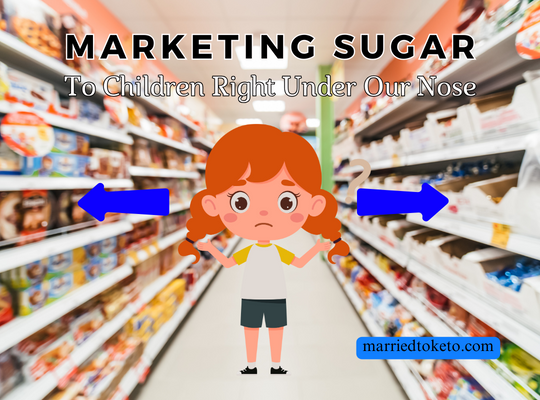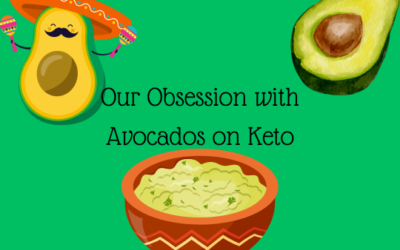I read an article on social media that researched sugary cereals being on eye level to children in the grocery stores. It stopped me in my tracks. Wait, they do that? The next time I was in a store, I looked and sure enough – they were about 23” off the floor. What in the actual…How long has this been going on? I felt a rant coming. Why are we marketing sugar to children.
The Research on Marketing Sugar to Children
I found an article released by Yale in 2009 about food companies marketing less healthy breakfast cereals to children. They studied the marketing efforts and the nutritional breakdown of 277 cereals. The cereal has 85% more sugar than those advertised to adults. They had 65% less fiber, 60% more sodium, and 42% of them had artificial food dyes in them.
What really got me was that the food industry had labeled many of these cereals as “better-for-you foods.” By whose standards? Well, by their own standards, naturally. These cereals included Cocoa Puffs and Cap’n Crunch, which are made up of 44% sugar. Fruit Loops and Lucky Charms at 41% sugar also made the cut. Cinnamon Toast Crunch is 32% sugar and also fell into this category.
In actual fact, only 8% of the cereals marketed to children met the health guidelines on sugar content for kids. How does this happen? How is this allowed? Why is no one holding these companies accountable? Why are they marketing sugar to children?
The Problem with Marketing Sugar to Children
So, what’s the big deal, you ask? I ate Fruit Loops and I turned out okay. The dietary guidelines for Americans says that children under the age of 2 should not have any added sugars. Those over 2 years old should have only 10% of their daily calories from added sugars. So, if they take in 2000 calories a day, only 200 of those calories should come from sugar which equals about 12 teaspoons. But, in 2017-18, the average child 2-19 took in 17 teaspoons of added sugars.
The risks of added sugar on children is really similar to those of adults. You risk obesity, which can lead to type 2 diabetes and heart disease. The up and down effects of sugar on your blood sugar levels can lead to mood changes and even depression. There is the increased risk of tooth decay. And, if you fill up on sugar, you don’t have room for nutritious foods you need.

The kicker though is that these risks increase the earlier they happen, so if you are obese as a child, you will struggle your entire life. The longer you have the blood sugar levels rising and crashing, the longer you will deal with mood changes, and picture going through that as your hormones are changing with puberty. And, is there a more important time to eat nutritious foods than while you’re growing?
How Companies are Marketing to Children
Marketers know that what you see is what you buy, so they make sure the sugary cereals are eye level to kids. From the research, it appears that food companies pay “slotting fees” to dictate where they are on the shelves. This is a win-win for the companies. The food companies sell more of their product and the grocery stores sell more product on their end. And, goodness knows, parents have enough to battle in a grocery store without dealing with their children begging for a certain item as if their lives depend on it.
If that wasn’t enough, cereal companies often use licensed characters (i.e. Dora the Explorer) to promote the cereal on the box. Or, they create their own cute, approachable character. These characters make the kids feel loyal to the brand. Furthermore, companies ensure the characters on the boxes have their gaze slightly downward to create eye contact with children. I kid you not.
Other Forms of Advertising
Of course, companies use other ways to market to children. They put advertisements on kids tv shows. The report I read said preschoolers see an average of 642 cereal ads per year, and almost all of them have the worst nutritional rankings. This is big business. They spend almost $156 million U.S. on television advertising per year.
The are websites approachable for children. They have “advergames” on the websites – games children can do for free online that have the main marketing character involved. This is a whole new way to create brand loyalty.
Final Thoughts on Marketing Sugar to Children
I have an issue with added sugars because I was addicted to it and didn’t even realize it. However, marketing to adults is one thing. We can read up on this stuff and recognize when we’re being manipulated, at least for the most part. But, when you play these mind games with children, that’s a new low in my books.
As long as the food industry is left to regulate themselves, this is not going to change. Because, the worst of it is, it’s working. These sugary cereals have been around since I was a kid (more than a couple of years ago) and they are still top sellers. As a parent, I hate that these companies were influencing my child, and actually me when I was a child. As a keto person, I hate that companies are putting kids on the road to eating and craving sugar. I think it’s time we put some guidelines in place to protect our families from the added sugar curse.
Wendy





